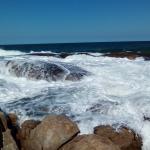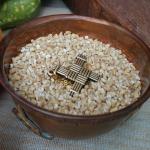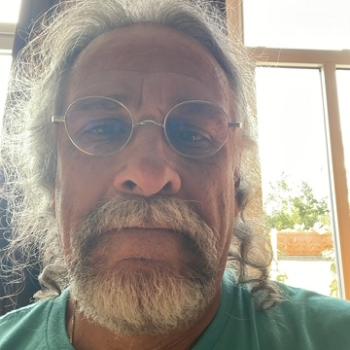Michael Dangler says, “…the cosmos is divided into three parts. What these three parts are and who inhabits them is far less important than their actual number.” in his article 9 Tenets of Druidic Ritual. He is speaking to the occurrence of three worlds (or multiples of them) in Indo-European paganisms. The evidence for the three worlds in Druidry and Gaelic paganism comes from basic oaths that exist within the lore (Mac Mathúna). The Celts, even the gods, would swear by the realms of Land, Sky, and Sea. Dagda makes a promise to the three men from whom he obtained his club right after reviving them.
‘Sun and moon, land and sea, provided that I slay my foes with it and bring my friends to life.’ Under that condition, a loan of the staff was given to him. – How the Dagda Got His Club, Yellow Book of Lecan (Bergin)
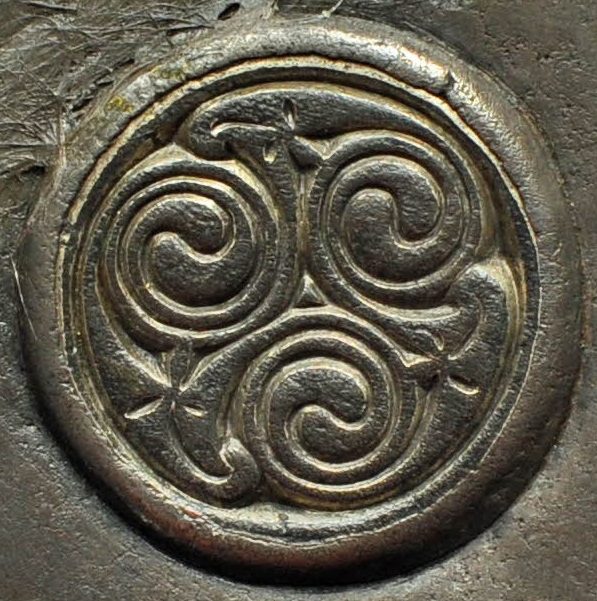
Additionally, the concept of a trifold world features in the Táin Bo Cúailnge in The Book of Leinster. Conchobor says,
‘for the sky is above us, the earth beneath us and the sea all around us, but unless the sky with its showers of stars fall upon the surface of the earth or unless the ground burst open in an earthquake, or unless the fish-abounding, blue-bordered sea come over the surface of existence, I shall bring back every cow to its byre and enclosure, every woman to her own abode and dwelling, after victory in battle and combat and contest.’
It appears in the constant warning of a character named Súaltaim in the Táin:
‘In nem maides fa muir thar chrícha fa thalam conscara fa gáir mo maic se,’ ol sé, ‘re n-éccomlonn?
‘Is it the sky that cracks, or the sea that overflows its boundaries, or the earth that splits, or is it the loud cry of my son fighting against odds?’
And there is this example from the story of Finding Cashel (Loughlin).
Bennacht nime, nél-bennacht,
Bennacht tíre, torad-bennacht,
Bennacht mara, íasc-bennacht.
The blessing of heaven, cloud-blessing,
The blessing of earth, fruit-blessing,
The blessing of sea, fish-blessing.
Bloody Bones on their blog discusses the possibility that mundane sky and sea emanate from Albios and Dumnos respectively. In this view, Samos projected from the fiery heavens creates nemos, the sky. This has an impact on the way we see land, sky, and sea. Sky and sea would be emanations of Sam-Giam opposition, and land would rise up from their interplay.

Segomaros places a conjectural world tree at the center of the triple cosmos (Segomaros). The four sacred trees about Ireland and the one in Uisneach provides a central pillar in a Gaelic pagan worldview. These aren’t conjectural, they are consistent with Indo-European cosmogony (Rees 120).
Prayer against the Fairies.—‘My father’s and grandfather’s idea was that the fairies tumbled out of the battlements of Heaven, falling earthward for three days and three nights as thick as hail; and that one third of them fell into the sea, one third on the land and one third remained in the air, in which places they will remain till the Day of Judgement. The old Manx people always believed that this fall of the fairies was due to the first sin, pride; and here is their prayer against the fairies:—“Jee saue mee voish cloan ny moyrn” (God preserve me from the children of pride [or ambition]).’ (Evans-Wentz, 84).
This world is made up of the joining of these three realms. The Otherworld can be seen as one or more separate worlds entirely, also joined by land, sky, and sea in parallel to this world.
The three realms not only pertain to this realm but the otherworldly regions which are their counterparts. While we may not be sure about Bloody Bones theory, we do know that Albios, the realm of the Celestial Gods, and Nemos (the sky) are related, but separate, one is accessed by way of the other. Just like Dumnos is accessed by way of the Sea. We can see by looking at stories of the fairies under the sea, or under mounds, are Christian accounts of a watered down and mutated worldview contained within the literature. Had we any first-hand accounts of tales from pagans we might have more distinction or more vivid a contrast, plus a view of how these realms connect. But honestly, most of what is reconstructed of Celtic pagan religion is conjecture seated atop the best founded scholarship and precedence. Good arguments can be made over the scraps, but none of it amounts to proof, and so most of this is a game of determining whose argument seems most sound and who is most diligent in their work.
The concept of an upper world and an underworld is common among Indo-European polytheisms, however, Ireland is unique in that it retained what seems to be a pre-Celtic tradition of calling the realm of spirit, the ‘otherworld’. In the Brythonic languages, Welsh and Gaulish, the word Anwyn or Annwfn referred to un-world, underworld, or great world (Koch 1403-1405). It seems that among Celtic speaking people outside of Ireland, belief that the gods resided in the celestial realms prevailed along with the dead, spirits, and underworld gods residing in the underworld.
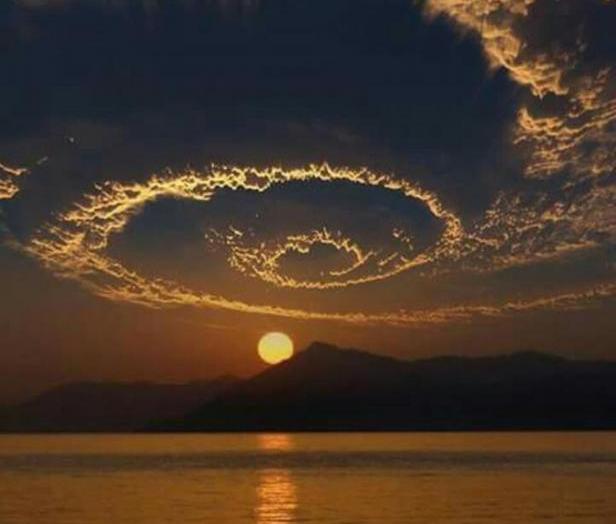
As Gaelic pagans, we can reconcile these two ideas by saying that Mag Mell and Tir na nog may be actually celestial paradises, the otherworldly isles of the gods, but isles among the stars accessible via the west. It is possible that the Otherworld Isles in the Imrama are Staints’ heavenly Christian Paradise (Wooding xiii-xv). In the Echtrae on the otherhand, the fairies usually pull you into the Otherworld, and its not your choice. Add to our view the places Scath and Teach Duinn as making up the rest of the Otherworld, but just at the top of the deep, of which the sea is the first layer. And we call all of it the Otherworld. All the isles visited in all the tales of journeys and imrams are part of this otherworld, and all of the fairy mounds that connect to the lower realms of the spirits and the dead, are domains of the celestial gods sure, but not their paradisiacal dwelling places where they are kept immortal by divine foods. But these places connect to the realms of the gods.
In Vedic paganism, the triple cosmos takes the form of terrestrial, atmospheric, celestial in Vedic paganism (Dangler). The most commonly seen in IE worldview are Underworld, Middleworld, and Upperworld (Dangler). This in ADF is called the vertical axis. While these are worlds, some hearth cultures refer to the divisions of the cosmos as realms. Three of these realms in Vedic paganism came from the dismemberment of the Giant, that is the Earth, Midair, and the Celestial realms (Thomas). While you find 9 worlds in Norse lore, you’ll find the triple cosmos expressed in Celtic paganism through vague references to Land, Sky, and Sea.
The realms of land, sky, and sea intersect this world and that of the otherworld or otherworlds. And all the worlds meet at the sacred center, the center of all, which is essentially “here” where we establish it, where the three realms meet.
Practical inclusion of Land, Sky, and Sea
In Ritual
When Mide, Nemed’s chief druid, entered Ireland, he kindled a seven-year fire at Uisneach. When the Vedic gods came to the world, the first thing they did is kindle a fire in the center of the world. This is the establishment of the Center Place. Our voices ring out from the Center Place to the edge and back again. The center place touches all things, all worlds, and is where our sacrifices can be made and sent anywhere in the cosmos. While Tara is the political center of Ireland, Uisneach is the magical and spiritual center. The reception of Imbas Forosnai inspires extemporaneous poetry. But it cannot be conveyed from one person to the next. The wisdom itself exists outside of the realms of symbols, and words are the most common symbols. This is symbolized when Mide killed the Fomorian druids who challenged him and, cut out their tongues and buried them in the hill where he kindled the fire according to Mide’s entry in the Dindseanchas part II (Gwynn 42-45). He answered the challenge with doing the great work. This also goes along with the consistent troupe of the fairies being displeased when you discuss experiences with them with others. Some parts of them are beyond articulation. In one story, a stream of fire flows forth from Uisneach (Carey and Koch 55-56), like the Five of water flow from Segais. Here we have representations of Samos and Giamos. And these relate to Land, Sky and Sea through them. When Alexander the Great met the Gauls, they told him that fire and water would prevail. We can consider these are Segais and Uisneach.
When we establish the sacred center in any litany, prayer, and ritual prose, we to establish it being at the threshold of land, sky, and sea. In my group, we consecrate and circumambulate a well, a fire, and a tree. When we get to the business of establishing the sacred center as a tree, we say:
O sacred pillar that stands at the center of the land the sky and the sea,
Let us be deepened in your depth,
Be raised to your heights,
And be strengthened in your strength.
A Chrann Naofa, fás istigh ionainn! (A Kron KNEE-fuh, FAWSH esh-TUH ANN-un)
Sacred Tree, Grow within us!
One opening prayer, based on Ceisiwr Serith’s prayers, is very common in practice among modern Indo-European pagans:
“The waters support and surround me,
The land extends about me,
The sky stretches out above me,
At the center burns a living flame.” (Serith 97).
We use something similar to open rituals:
The Land upholds us (me),
The Sea surrounds us (me),
As the Sky embraces us (me),
We (I) stand at the center as living flames.
In Prayers and Oaths
We’ve already demonstrated this through ritual prayer. However, you may do all sorts of things with land, sky, sea, and prayer. Many Gaelic prayers which encapsulate the spirit of Gaelic poetry and mysticism include triplicities that are Christian. You can view these as candidates to insert triplicities from Gaelic paganism that are known to us from the Irish pagan remnants in the lore. You can rewrite these prayers with the three Morrigan, with Brighid as three sisters, or with Land, Sky, and Sea.
It isn’t so Christian to swear by things and pray by things. In fact, I suspect that Christianity aimed to narrow the many things pagans swore by, in order get them to pray through and swear oaths through their faith in Jesus. And so, “Through Jesus name we pray,” very well could be a replacement for things pagan. Not every prayer has to be directed through the same roads, avenues. Praying to Manannan would end with, “By way of Sea-Foam, He hears me.” The same goes for LS&S trio. “From the Land, Under Sky, and O’er Sea, the wings of my words stretch out and fly o’er Manannan’s gate!”
Praying by and swearing oaths are not separate acts, but instead are different aspects of the spectrum of two parties interacting. All oaths are between two parties. All prayers in request or praise are between allies, be it human or divine. Our gifts to one another are the same thing as our gifts to the gods. When we swear an oath to someone, while we are not praying, we are doing a similar interaction. Votive sacrifices combine both of these so that the oath is related to prayer and the gift cycle. Swearing by Land, Sky, and Sea is becoming of our ancestors and so it suits us as well.
In Journeywork
The hills of Uisneach and Tlachtga are the places of the Bealtaine and Samhain fires, respectively. They have raised places because raised places are seen as liminal. That the ground reaches up toward the sky, is a kind of coincedentia oppositorum. Like a plant that grows in the sky, such as mistletoe, these things which represent a unity of opposites, are what our ancestors clung onto as liminal, sacred, and often as doorways.
You can go meditate upon a hill, see mists surrounding you and when they recede you realize you’re sitting on the hill of Tara, or Tlachtga. It helps if you’ve been there but I recommend at least looking at pictures of these places, which won’t do them justice but will at least give you a better footing than what your own imagination can provide. But once the mists recede, you can then embark on an echtrae type adventure. You can do the same thing near the sea or down in a ravine or cave. In this way, you can go into nature, and using sacred points of land sky and sea to anchor onto the reception of data to the otherworld.
We don’t have any proof that imagined guided journeys are a Celtic practice. In the seership described in Irish paganism, the wisdom comes to you, and not you to it. In this way, journeys can still be used but they’re seen as an exploration of a packet of wisdom, rather than the observation of another spiritual world. This is also alluded to in analysis of manuscripts recording practices of British Leechcraft. The Irish ways of seeing are going to be founded on the greater Indo-European practices of mysticism. There is much doubt cast on the Imrama as pre-Christian according to ‘The Otherworld Voyage in Early Irish Literature’ by Jonathan M. Wooding. The same kind of doubt is cast on Ogham and we use them just the same. In fact, Wooding and Carey illustrate how all the Imrama have a single Latin ancestor: Nauigatio Brendani.
In Devotional Acts
You may decide to do pilgrimages over land, over the sky, and over a body of water. This can include pilgrimage back to your ancestral homeland, or to points on the map you deem sacred. Your sky pilgrimage can be a plane flight to Ireland or Scottland. You can do all night vigils at the sea, upon land or high up in the mountains. You may decide to do climbing, skydiving, or scuba diving in order to gain a visceral experience of these realms.
You may decide to break up a singular devotional act into three separate ones using land, sky, and sea to ‘multi-plex’ your acts of devotion. Something along these lines, the first day you would offer water offerings of fish and seaweed. You would offer land blessings such as milk, butter, and oil on the second day. Upon the third, one could make cloud offerings of incense.
In Draíocht (Magic)
The same thing can be said for magic as can be said for prayers, devotion, journey work in ritual. Magic is where all these blend into the same thing. Here is where you can use substances that are land sky and sea in your folk magics. Folk magic revolves around taking substances in the natural world and transforming them. It is proto-alchemical in the sense that a pater-noster incantation seven times transmutes a normal thing into an amulet.
When creating talismans, which are objects with power, we can work with spirits of land, sky, and sea to bring in properties that aid control over those specific realms. Talismans, in the folklore, have their power presumably because the maker allowed a spirit to come live in the object. So you can perform rites around weather talismans, for instance, inviting some of the fairies that live in the sky to live there. You make an agreement with the spirit that is equitable for both parties. Making bargains with fairies is not advised unless they’ve befriended you already.
Sources
Dangler, Michael. “Nine Central Tenets of Druidic Ritual.” ADF Website, 21 Oct. 2010, 11:42, www.adf.org/articles/cosmology/nine-tenets.html.
Jones, Mary. “Celtic Cosmogony and Eschatology.” AKA Mary Jones, www.maryjones.us/jce/cosmogony.html.
Koch, John T. Celtic Culture: a Historical Encyclopedia. ABC-CLIO, 2006.
Loughlin, Annie. “Sources for the Three Realms.” Tairis, www.tairis.co.uk/cosmology/sources-for-the-three-realms/.
Mac Mathúna, Liam. “Irish Perceptions of the Cosmos.” Celtica, vol. 23, 1999, pp. 174–187.
Serith, Ceisiwr. Deep Ancestors: Practicing the Religion of the Proto-Indo-Europeans. Kindle ed. ADF Pub., 2009.
Thomas, Kirk. Sacred Gifts. ADF Publishing, 2007.
Bergin, Osborn. “How the Dagda Got His Magic Staff.” AKA Mary Jones, Mary Jones, www.maryjones.us/ctexts/dagda.html.
Segomaros. “Samos, Giamos, Bitouesc – Summer, Winter, and Worlds – Polytheist.com.” Polytheist.com, 26 Apr. 2015, polytheist.com/segomaros/2015/03/04/samos-giamos-bitouesc/.
Rees, Alwyn D., and B. R. Rees. Celtic Heritage: Ancient Tradition in Ireland and Wales. Thames and Hudson, 1994.
Bones, Bloody. “Worldview: Samos, Giamos, and the Seasons.” Nemeton Nigromanticos, 6 July 2015, thebloodybones.wordpress.com/2015/07/06/worldview-samos-giamos-and-the-seasons/.
Evans-Wentz, W. Y. The Fairy-Faith in Celtic Countries. Kindle ed., Pantianos Classics, 2018.
Gwynn, Edward. The Metrical Dindshenchas. Dublin Institute for Advanced Studies, 1991.
Carey, John, and John T. Koch. The Celtic Heroic Age: Literary Sources for Ancient Celtic Europe & Early Ireland & Wales. Celtic Studies Publ, 2009.
Wooding, Jonathan M.. The Otherworld Voyage in Early Irish Literature: an Anthology of Criticism. Four Courts Press, 2014.


